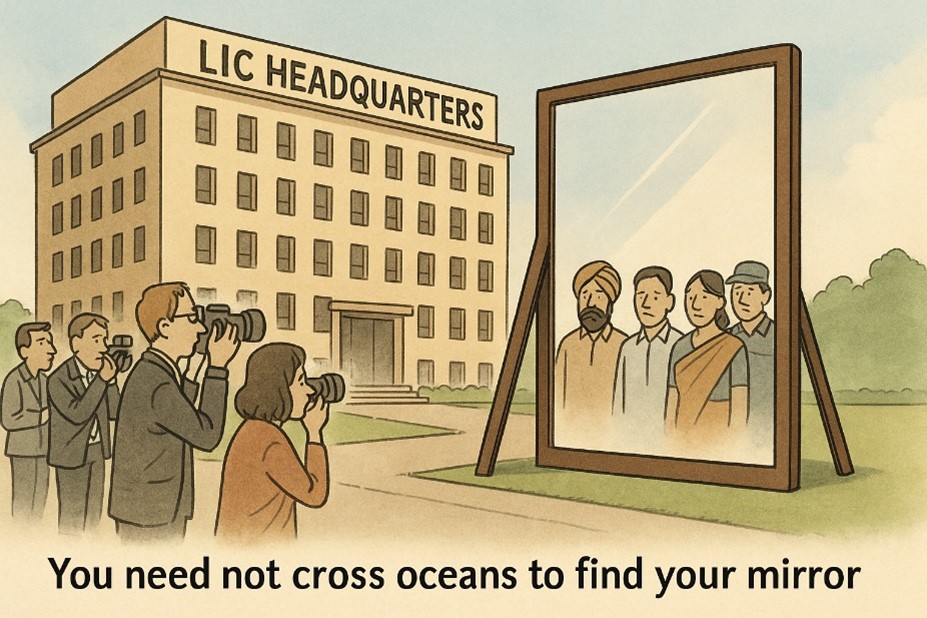



Why the debate around LIC and Adani isn’t about foreign criticism, but about how we define accountability at home.
By Ravishankar Kalyanasundaram
The Allegation and the Silence
When The Washington Post claimed that India’s largest insurer was being nudged into a ₹33,000 crore investment in the Adani Group, the denial came fast. “Baseless,” said the Life Insurance Corporation of India. And perhaps it was. Yet the more pressing question is not about the veracity of a report published in Washington, but about the silence that followed here at home.
Why does it take an allegation from abroad for our institutions to explain themselves with clarity? And why do explanations, when they come, sound less like disclosures and more like damage control?
The Vault of Middle-Class India
LIC is no ordinary investor. It is the quiet vault of middle-class India — the patient savings of schoolteachers, postal clerks, and small-town traders who bought their first policy decades ago and still keep the paper neatly folded in steel cupboards. Its Sanskrit motto, Yogakshemam Vahamyaham — “your welfare is our responsibility” — has long been a promise of safety, not speculation.
And yet, every few years, that promise is tested. The Adani share-collapse storm of 2023 was one such moment. LIC’s exposure, exceeding ₹30,000 crore, raised eyebrows not for the investment itself but for the opacity surrounding it. “We invest within approved limits,” the chairman said, but by then markets — and millions of policyholders — had already filled in their own conclusions.
A History of Quiet Interventions
This was not the first time LIC’s cheque book was caught in political crosswinds. A decade earlier, it had quietly acquired a controlling stake in the struggling IDBI Bank — a move branded “strategic,” but widely viewed as a bailout that served the government’s fiscal convenience. The insurer’s later partial exits and the bank’s slow revival did little to erase the impression that LIC’s hand was guided as much by public policy as by portfolio prudence.
Through all of this, LIC has survived and prospered — profitable, solvent, and deeply trusted. It has weathered disinvestment debates, regulatory reforms, and the glare of its 2022 IPO. Yet that listing, meant to usher in transparency, raised fresh doubts about valuation, disclosure and governance. In trying to serve both state and market, LIC often ends up speaking two dialects — one bureaucratic, the other financial — and mastering neither.
A Mirror, Not a Lecture
The Washington Post’s story, then, touches a nerve not because it reveals something new but because it reminds India of what it already knows: transparency is still rationed. The instinctive reaction — to accuse the West of hypocrisy — is emotionally satisfying but strategically empty. For if one were to cross the ocean and look closely, America’s own mirrors are fogged with moral clutter.
From the sub-prime mortgage disaster of 2008 to the Silicon Valley Bank collapse in 2023, the U.S. financial establishment has repeatedly shown how opacity hides behind jargon until it explodes. Trillion-dollar bailouts justified under “too big to fail” erased the line between private greed and public rescue. So yes, Washington may write its stories, but it hardly owns the moral high ground.
And precisely for that reason, India must build its own.
The Comfort of Secrecy
The issue is not corruption; it is comfort. Decades of monopoly have bred an instinct for secrecy that no IPO can wash away. LIC still speaks the language of the ministry more fluently than that of the market. Its press releases sound like circulars. Its annual reports, though thick with data, seldom tell a story. The very architecture of its governance — with government appointees on the board and revolving-door directors — reinforces the suspicion that the watchdog sleeps too close to the gatekeeper.
But that age of deference is ending. Policyholders today have context, comparisons, and curiosity. They know that Norway’s sovereign fund publishes every holding; that Singapore’s Temasek explains its rationale in plain prose; that even Japan’s postal savings fund details its sectoral exposure. They have seen how clarity preserves trust even in crisis — and they expect the same from India’s financial giants.
What Transparency Would Look Like
Accountability, in truth, isn’t complicated. It means proactive disclosure — sectoral exposure, concentration thresholds, conflict-of-interest rules. It means a governance charter that shows how far North Block’s hand truly reaches. It could even mean a public dashboard, updated quarterly, on how the nation’s pooled savings are deployed.
Transparency is not surrender. It is what earns an institution its autonomy. Every time the government speaks for LIC, it diminishes LIC’s own voice. And every time LIC stays silent, it invites others — a journalist, an activist, or a rival conglomerate — to narrate its story instead.
If LIC were to respond not with indignation but with information — not “baseless” but “here are the facts” — it would achieve something rare in Indian public life: the credibility that comes from openness, not ownership.
The New Standard of Trust
India is no longer a back-office economy. Its state-owned giants now operate in global capital markets where scrutiny is relentless and investors impatient. Respect in that arena will not be earned by rebuttal but by routine transparency. The moral high ground belongs not to those who shout loudest but to those who disclose most willingly.
So let the foreign press write what it will. The stronger reply lies not in press statements but in reform. The mirror need not cross oceans — it stands right here, reflecting both the achievements and the absences of our own institutions.
Because in the end, the house we must keep in order is not theirs. It is ours.